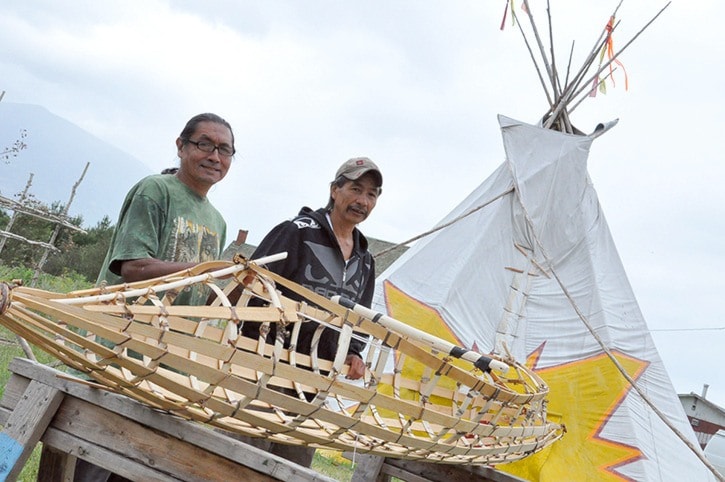There hasn’t been a sturgeon-nosed canoe on the Kootenay River for decades, but a project by Lower Kootenay Band member Wayne Louie is about to change that.
He was commissioned by the Ktunaxa Nation to build a 12-foot canoe for the Sept. 28 Columbia Salmon Festival in Invermere, and has been working on it since early June, completing the frame on Thursday and attaching the skin this weekend.
“It’s made of all natural resources like my ancestors used to do,” said Louie, who has been assisted by Richard Jacobs.
That means no nails, screws or anything prefabricated is part of the design — the western maple and cedar frame is tied together with cedar roots and bitter cherry bark (the electrician’s tape that held parts together during the construction was removed as those parts were tied together).
Once the white pine bark was attached, Louie said it would be cured in the shade for about 10 days — the sun would heat the canoe too quickly, twisting it out of shape — so the pitch from the bark would seal the skin, making the vessel waterproof.
Just as Eastern Canada’s Ojibwa and Algonquin used birch bark, and the B.C. Coast’s Haida and Nisga’a used cedar, white pine bark was the covering of choice for the area’s First Nations.
“There was an abundance of white pine in the old days,” Louie said.
Named for its distinctive pointed ends resembling a sturgeon’s head, allowing easier navigation through bulrushes, canoes as big as 16 or 20 feet were used on the Kootenay and Arrow lakes.
They are also lightweight — Louie easily lifts it with one hand — making it easy to portage. That can make fishing a bit tricky, though, said Louie, who related a story of a band member hooking a sturgeon that towed him all the way to Kootenay Lake.
“If you catch a five-pound fish, it will pull you,” he added.
A century ago, it wouldn’t have been uncommon to see similar canoes traveling along Kootenay River.
“Every household had a canoe because that was their transportation,” said Louie. “We weren’t horse Indians.”
Now in his late 50s, Louie hasn’t seen a white pine bark canoe on the river since he was a kid, and appreciates the opportunity to make one.
“It shows people we’ve still got our culture,” he said. “It’s not extinct.”
